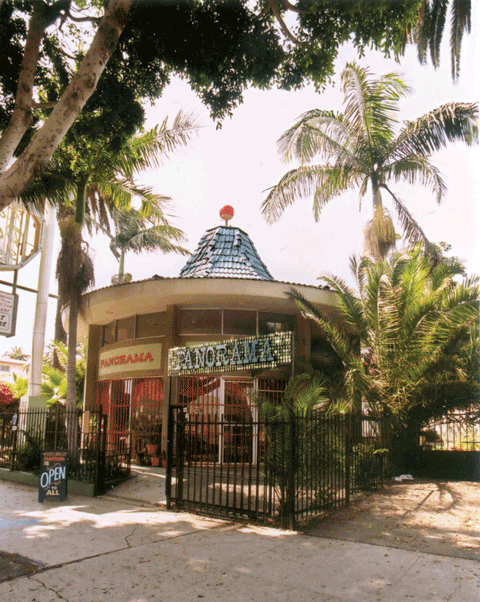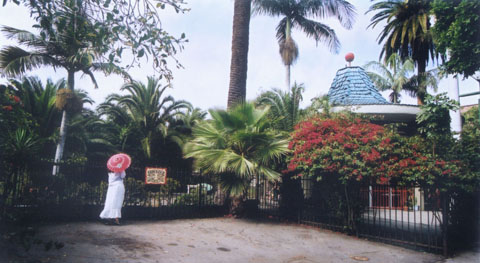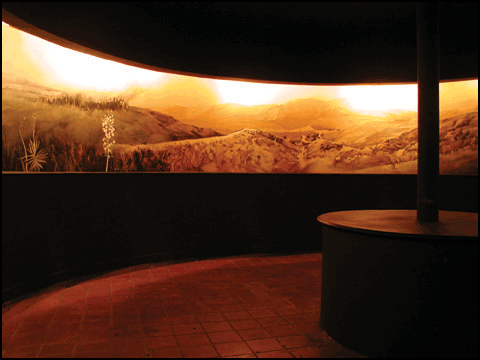Former Hollywood Location
The Velaslavasay Panorama was founded in the year 2000 at the Tswuun-Tswuun Rotunda, in Hollywood. The main feature of the exhibit was the 360-degree Panorama of the Valley of the Smokes, which, along with the magnificent garden area and Avian Alcove, proved a singular attraction amidst the unique cultural surroundings of Southern California.
Sadly, the Tswuun-Tswuun Rotunda is no longer extant, with all the surrounding greenery and century-old palms gone with it. Our former home still lives vibrantly in our memories, and in the remembrances of our devoted friends and proud, dutiful members.
Tswuun-Tswuun Rotunda, Home of the Velaslavasay Panorama in Hollywood 2000-2004
Built in 1968 in the courtyard of a 1913 brick Tenement House, the Tswuun-Tswuun Rotunda bears curious resemblance to the Great Panorama Rotundas of the 19th century. Initially home to a Chinese-Polynesian Restaurant [The Chu-Chu Chinese - Mr. David Chu, proprietor], throughout the years the Tswuun-Tswuun Rotunda housed a variety of business ventures incuding a Korean BBQ, an ice cream parlor, a pizza restaurant, a travel agency and an Armenian bakery until meeting its eventual destiny as a panoramic exhibition hall.
Former Location on Hollywood Boulevard
On that grand boulevard known for such landmark venues as the extravagant and historic Egyptian and Chinese Theatres and nearby Cinerama Dome, The Velaslavasay Panorama was indeed proud to be part of a neighborhood known the world over for great spectacle and showmanship.
The lush gardens of our Hollywood location were the site of numerous events, sociables, and festive soirées, and the well-appointed grounds provided a calming effect for all who entered there. Flora featured in the garden included a variety of aged palms, snow-white rose bushes, banana trees and collection of fine succulents, many of which have been transplanted to our current location at the Union Theatre.
Panorama Gardens and Avian Alcove, a living diorama featuring the feral tropical parrots of Greater Los Angeles.
Making its premiere in 2002 as Hollywood's first ever Living Diorama, The Avian Alcove was a garden extravaganza displaying the sights and sounds of a lush tropical world inhabited by exotic flora and flying feathered fauna. Both animate and inanimate, two- and three-dimensional, these plants and birds transported the visitor to the subtropical regions through visual, tactile, aural and olfactory sensation.
The picturesque aviary doubled as a fantastical photography studio, where visitors could have their portraits taken standing beside an elaborately painted backdrop with hand-crafted avian models and cultivated plants, all whilst taking in the auditory callings of avian wildlife. In effect, visitors to The Avian Alcove became part of the exhibit themselves, while learning a bit of local ornithological history.
The exhibit highlighted local parrot species, including Amazona Orchrocephala Oratix, which reside in the Canary Island Date Palm - Phoenix canariensis - which is widely spread throughout the Los Angeles area, including the rotunda's own erstwhile grounds. The diorama also painted a nostalgic portrait of North America's only native parrot species - Psitacus carolinenssis - the Carolina Parakeet, which sadly met its extinction in 1918. A seamless blend of horticulture, handicraft and habitation re-creation, The Avian Alcove presented a truly landscopic experience, and is fondly remembered.
Panorama of the Valley of the Smokes
The main attraction at our Hollywood Boulevard location was the magnificent Panorama of the Valley of the Smokes, a rendering of what California's Southland might have looked like 200 years ago. Upon entering the rotunda, visitors proceeded down a dimly lit hallway lined with amber glass sconces. Entering through a dark doorway, they were suddenly surrounded by the painting, illustrating sparse hillsides and windswept plains in muted yellow tones, and conveying a dramatic sense of otherworldly atmosphere. Emphasizing the beauty of the setting which drew people to the area long ago, the Panorama of the Valley of the Smokes suggests to viewers that this mysterious sensation still can be found in the landscape of Los Angeles.



